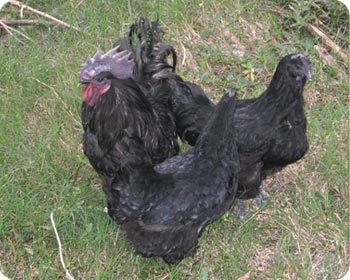
人类一直都对家养动物的特征感兴趣,并学会了如何通过选育将这些特征继续下去。这导致了家养动物的基因快速进化。现在,人们可以研究这种进化过程,并用它来解释基本的进化学原理。今天,一项有关乌骨鸡的研究成果被发表。乌骨鸡带有一个特定的基因变化,而该变化在家养动物的进化中起到了极大作用。
“我们有极大理由相信,类似于在这种鸡身上所发生的遗传物质的变化也在人类和其它物种的进化中起到了极大的作用”,主持该研究的Leif Andersson教授这么说。
在被发表在《PloS Genetics》杂志上的这项研究中,Uppsala大学的科研人员和瑞典农业大学、美国卡罗琳娜州立大学以及台湾的国立中兴大学的科研同事们发现了引起鸡类比如中国乌骨鸡纤维色素增生(fibromelanosis)的原因。该特征意味着色素细胞大量增长,以至于皮肤和内脏均变为黑色。这种鸡在中国的烹调艺术和中国传统医药上非常重要。马可•波罗在1200年代访问中国时便描述了这么一种类似的鸡。
科研人员们显示该特征基于一种在遗传物质内发生的、被称为重组的变化(请见解释框),该变化导致了一种名为Endothelin 3的蛋白质的形成被增加了。
“该蛋白质是影响色素细胞发育的一个主要因素。总之,色素细胞过量生成,而过量的色素细胞产生大量的黑色素”,Uppsala大学的博士后Ben Dorshorst说。
由Leif Andersson主导的该科研小组目前已经搞清了家养动物的很多特征,并总结出了一个明显的规律,即这类重组是改变家养动物特征的主要原因。其它例子是马类的白色和鸡类的鸡冠的大小和形状。
瑞典有一种带有纤维色素增生的特别的农家鸡:Bohuslän-Dals黑鸡。科研人员们发现这种鸡带有和乌骨鸡一模一样的基因变异。Leif Andersson认为,这和传说所述的内容不谋而合:即这种鸡的黑颜色来自由挪威的东印度船带回来的几只中国鸡,然后这个特征被传播到了瑞典。
“这个例子说明我们在培育我们的家养动物时是如何将我们喜欢的基因变异四处传播的。很明显,我们人类从很早起就特别喜欢生物多样性,这甚至包括我们的家养动物”,他说。
相关解释:
所谓的遗传物质重组是指某一段DNA被重复(基因复制)、某一部分DNA消失了(基因缺失)和/或DNA片段被反向(基因转向)。复杂的基因重组指发生了两个或多个重组。在乌骨鸡的例子中,科研人员发现两个紧邻的DNA片段被复制,同时这两个被复制的片段中的一个被反向 。
Dermal hyperpigmentation or Fibromelanosis (FM) is one of the few examples of skin pigmentation phenotypes in the chicken, where most other pigmentation variants influence feather color and patterning. The Silkie chicken is the most widespread and well-studied breed displaying this phenotype. The presence of the dominant FM allele results in extensive pigmentation of the dermal layer of skin and the majority of internal connective tissue. Here we identify the causal mutation of FM as an inverted duplication and junction of two genomic regions separated by more than 400 kb in wild-type individuals. One of these duplicated regions contains endothelin 3 (EDN3), a gene with a known role in promoting melanoblast proliferation. We show that EDN3 expression is increased in the developing Silkie embryo during the time in which melanoblasts are migrating, and elevated levels of expression are maintained in the adult skin tissue. We have examined four different chicken breeds from both Asia and Europe displaying dermalhyperpigmentation and conclude that the same structural variant underlies this phenotype in all chicken breeds. This complex genomic rearrangement causing a specific monogenic trait in the chicken illustrates how novel mutations with major phenotypic effects have been reused during breed formation in domestic animals.


